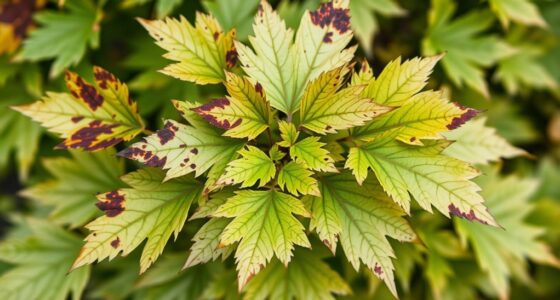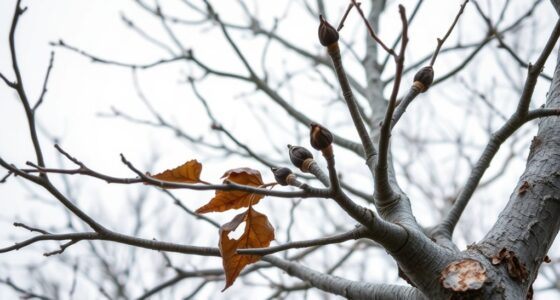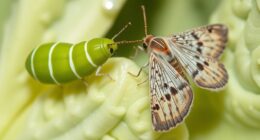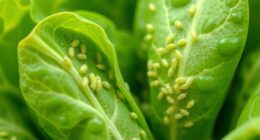If your Sunshine Ligustrum isn’t growing well, it could be due to improper soil pH, poor fertility, or insufficient light. Make sure your soil has the right pH level—test regularly and adjust with lime or sulfur if needed. Also, check if the plant gets enough sunlight, ideally full sun for 6-8 hours daily. Improving soil fertility with compost and proper fertilization can boost growth. Continue exploring to discover how to optimize these factors effectively.
Key Takeaways
- Ensure the soil pH is between 6.0 and 7.0; test regularly and amend with lime or sulfur as needed.
- Check for nutrient deficiencies by observing leaf color and consider applying balanced, slow-release fertilizers.
- Provide at least 6 hours of direct sunlight daily; move the plant to a sunnier location if growth stalls.
- Improve soil fertility by adding organic matter like compost and correcting nutrient imbalances with targeted amendments.
- Avoid overwatering to prevent nutrient leaching and promote healthy root development for better growth.
Understanding the Role of Soil Ph in Plant Growth

Soil pH substantially influences how well your Sunshine Ligustrum grows because it affects the availability of nutrients in the soil. To maintain ideal pH levels, you should regularly perform pH monitoring using a reliable tester. If the soil is too acidic or alkaline, your plant may struggle to absorb essential nutrients. In such cases, soil amendments can help correct the pH. For example, adding lime can raise pH levels in acidic soils, while sulfur or peat moss can lower pH in alkaline soils. Regularly adjusting and monitoring soil pH ensures your Sunshine Ligustrum receives the nutrients it needs for healthy growth. Staying proactive with pH management keeps your plant thriving and prevents growth issues caused by unsuitable soil conditions. Additionally, understanding the role of natural materials in soil composition can help optimize plant health.
How Soil Fertility Affects Sunshine Ligustrum Development

If your Sunshine Ligustrum isn’t thriving, it might be a sign of nutrient deficiencies. You should look for symptoms like yellowing leaves or stunted growth, which indicate the soil’s fertility needs boosting. Applying the right fertilizer tips can help restore nutrient levels and promote healthy development. Ensuring proper soil fertility and nutrient balance is essential for optimal plant health. Additionally, maintaining appropriate soil pH levels can significantly influence nutrient availability and overall plant vitality.
Nutrient Deficiency Signs
When nutrient deficiencies occur, you’ll notice clear signs that your Sunshine Ligustrum isn’t getting what it needs to thrive. Yellowing leaves or stunted growth often indicate a lack of essential nutrients like nitrogen or iron. You might also see new leaves fail to develop properly or fall prematurely. Poor soil fertility can weaken the plant’s overall health, making it more susceptible to pest infestations. Additionally, improper watering practices can worsen deficiencies by washing away nutrients or preventing roots from absorbing them effectively. Keep an eye on leaf color and growth patterns; these signs help you identify if your plant needs better soil nutrition. Recognizing soil pH that suit your plant’s needs can also help in creating a nurturing environment. Ensuring optimal soil fertility supports nutrient uptake and promotes healthy growth. Addressing these issues promptly ensures your Sunshine Ligustrum remains healthy and vibrant.
Fertilizer Application Tips
Applying the right fertilizer is essential for maintaining soil fertility and promoting healthy growth in your Sunshine Ligustrum. Proper fertilization guarantees the plant gets necessary nutrients, supports pest control, and prevents deficiencies that hinder development. When fertilizing, consider these tips:
- Use a balanced, slow-release fertilizer tailored for shrubs.
- Apply fertilizer during the active growing season, avoiding overfeeding.
- Water thoroughly after fertilizing to help nutrients reach roots and improve watering techniques.
- Regularly monitor soil pH to assure nutrients are accessible to the plant.
- Staying informed about AI safety measures can help prevent issues related to automated garden management systems and ensure your gardening tools operate securely.
The Impact of Light Conditions on Shrub Health

Light conditions play a crucial role in the health and growth of Sunshine Ligustrum. Proper light guarantees vibrant foliage and vigorous flowering. If you provide too much shade, the shrub may become leggy and sparse, affecting its overall appearance. Conversely, too much direct sunlight can scorch leaves. Understanding shade tolerance helps you position your plant correctly. Additionally, soil pH influences how well the plant absorbs nutrients, further impacting its growth. Regular pruning practices also optimize light exposure and promote healthy growth. Recognizing the optimal light levels for your shrub ensures it remains healthy and thrives in your garden.
Testing and Adjusting Soil Ph for Optimal Growth

Testing and adjusting your soil pH is essential for guaranteeing Sunshine Ligustrum thrives. Proper pH levels help your plant absorb nutrients effectively. To start, perform a pH testing using a reliable soil test kit or send a sample to a lab. Once you know the pH, you can make targeted soil amendments to correct it. Here are key steps:
- Identify whether your soil is too acidic or alkaline.
- Use lime to raise soil pH if it’s too acidic.
- Use sulfur or peat moss to lower pH if it’s too alkaline.
- Re-test after amendments to ensure ideal pH levels. Regular monitoring is important to maintain optimal conditions for your plant’s health. Soil testing methods can provide more accurate results for better adjustments. Maintaining a balanced soil pH between 6.0 and 7.0 encourages healthy growth. Soil fertility also plays a crucial role in plant development, so consider testing nutrient levels alongside pH. Regular pH testing keeps your Sunshine Ligustrum happy and thriving.
Improving Soil Fertility With Proper Amendments

To boost your soil’s fertility, start by adding organic matter like compost or aged manure, which enhance structure and nutrient availability. Next, identify and correct any nutrient deficiencies with targeted amendments to guarantee your plant gets what it needs. Incorporating soil testing can help determine specific nutrient gaps and guide your fertilization plan for optimal plant health. Additionally, understanding the soil pH helps ensure nutrients are accessible to your Sunshine Ligustrum, preventing deficiencies caused by imbalanced acidity or alkalinity. Proper soil amendments can also improve overall soil health and support sustained growth. Finally, use a balanced fertilizer to provide essential nutrients, supporting healthy growth for your Sunshine Ligustrum.
Organic Matter Enhancement
Enhancing soil fertility is essential for healthy Sunshine Ligustrum growth, and adding organic matter is one of the most effective ways to achieve this. Organic matter improves soil structure, boosts nutrient retention, and encourages beneficial microbes. You can incorporate organic compost into the soil or use mulching benefits to protect and enrich the root zone. Here are some ways to enhance organic matter:
- Mix compost into the soil before planting or as a top dressing.
- Apply a thick layer of mulch, such as bark or straw, to conserve moisture.
- Incorporate well-rotted organic waste regularly.
- Use organic compost as a fertilizer supplement for ongoing nourishment.
Adding soil amendments can further improve nutrient availability and overall soil health.
These practices improve soil health, promote vigorous growth, and help your Sunshine Ligustrum thrive.
Correcting Nutrient Deficiencies
When your Sunshine Ligustrum shows signs of poor growth or yellowing leaves, it’s often a sign that the soil is lacking essential nutrients. To correct this, start by testing your soil’s nutrient levels. Adjust your watering schedule to prevent leaching of nutrients—overwatering can wash them away. Incorporate proper amendments like compost or slow-release fertilizers rich in nitrogen, phosphorus, and potassium. Regular pruning techniques help improve air circulation and stimulate healthy growth, making your plant more receptive to nutrients. Use the table below to understand which amendments support specific deficiencies:
| Deficiency | Amendment | Benefit |
|---|---|---|
| Nitrogen | Compost, blood meal | Promotes lush, green growth |
| Phosphorus | Bone meal, rock phosphate | Encourages root development |
| Potassium | Potash, banana peels | Strengthens overall health |
Additionally, understanding the soil pH can significantly influence nutrient availability and uptake by your Sunshine Ligustrum.
Balanced Fertilizer Use
Using a balanced fertilizer is key to maintaining healthy soil that supports vigorous Sunshine Ligustrum growth. Proper fertilization boosts soil fertility, ensuring your plant gets essential nutrients. To optimize results, follow these tips:
- Apply fertilizer according to the recommended watering schedules to prevent over- or under- fertilizing.
- Use a balanced formula with equal parts nitrogen, phosphorus, and potassium for overall health.
- Incorporate organic amendments like compost to improve soil structure and nutrient availability.
- Combine fertilization with proper pruning techniques to remove dead or weak growth, encouraging new, healthy shoots.
- Regularly monitor soil pH levels to maintain optimal conditions for nutrient uptake. Ensuring the soil has the correct soil fertility is essential for healthy growth.
- Consistent fertilization paired with attentive watering and pruning habits promotes soil robustness, helping your Sunshine Ligustrum thrive and grow densely.
- Additionally, conducting periodic soil tests can help identify specific deficiencies and guide targeted amendments for better plant health.
Optimizing Light Exposure for Your Sunshine Ligustrum

To guarantee your Sunshine Ligustrum thrives, providing it with the right amount of light is essential. Make certain it receives full sun, ideally 6-8 hours daily, for ideal growth. If growth stalls, consider pruning techniques to remove dead or crowded branches, which improves light penetration and airflow. Proper pruning also helps prevent pest issues by reducing hiding spots. Use the following table to maximize light exposure:
| Light Condition | Action |
|---|---|
| Too Shady | Move plant to sunnier spot |
| Partial Sun | Make sure at least 4 hours daily |
| Full Sun | Maintain consistent exposure |
Frequently Asked Questions
Can Sunshine Ligustrum Survive in Shade Environments?
Sunshine Ligustrum has limited shade tolerance, so it generally needs plenty of sunlight to thrive. While it can tolerate some partial shade, it won’t grow as vigorously in full shade environments. To guarantee healthy growth, you should provide it with the right sunlight needs, ideally at least 4-6 hours of direct sunlight daily. If you keep it in shade, expect slower growth and potentially less vibrant foliage.
What Are Signs of Nutrient Deficiencies in Sunshine Ligustrum?
You might notice foliage discoloration, such as yellowing or pale leaves, and stunted growth, which are signs of nutrient deficiencies in your Sunshine Ligustrum. These symptoms indicate your plant isn’t getting essential nutrients like nitrogen, iron, or magnesium. To fix this, you should test your soil and amend it with appropriate fertilizers. Addressing these deficiencies promptly helps restore healthy foliage and encourages proper growth.
How Often Should I Test My Soil’s Ph Levels?
You should test your soil’s pH levels at least once a year to ensure ideal conditions. Regular soil testing helps you monitor pH levels and adjust them if necessary, promoting healthy plant growth. If you notice growth issues or seasonal changes, consider testing more frequently, like every 6 months. Consistent pH level checks allow you to catch imbalances early and maintain a thriving garden environment.
Which Soil Amendments Best Improve Fertility for Shrubs?
Imagine your garden as a thriving symphony, and the right amendments are the notes that bring it alive. Compost application works wonders, enriching soil with essential nutrients. Adding organic matter boosts fertility, giving your shrubs the foundation they need to flourish. These amendments create a vibrant, fertile environment, turning dull soil into a nourishing bed where plants can grow strong and healthy, filling your garden with life and color.
How Does Watering Frequency Influence Sunshine Ligustrum’s Growth?
Your watering schedule directly impacts Sunshine Ligustrum’s growth by influencing moisture retention in the soil. Water consistently enough to keep the soil moist but not soggy, ensuring roots get enough hydration without drowning. Overwatering can lead to root rot, while underwatering causes stress. Adjust your watering frequency based on weather and soil conditions, maintaining a balance that promotes healthy growth and prevents issues related to moisture imbalance.
Conclusion
Think of your Sunshine Ligustrum as a delicate recipe—you need the right ingredients in the right balance. I once struggled with my own shrub until I adjusted the soil pH and improved its light. Once I did, it thrived like a well-fed flame. Remember, small tweaks in soil fertility, pH, and light can turn your struggling plant into a vibrant centerpiece. With patience and attention, you’ll help your shrub flourish just like I did.









